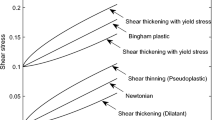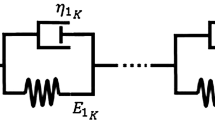Abstract
The widely popular quasi-linear viscoelasticity (QLV) theory has been employed extensively in the literature for characterising the time-dependent behaviour of many biological tissues, including the aortic valve (AV). However, in contrast to other tissues, application of QLV to AV data has been met with varying success, with studies reporting discrepancies in the values of the associated quantified parameters for data collected from different timescales in experiments. Furthermore, some studies investigating the stress-relaxation phenomenon in valvular tissues have suggested discrete relaxation spectra, as an alternative to the continuous spectrum proposed by the QLV. These indications put forward a more fundamental question: Is the time-dependent behaviour of the aortic valve intrinsically quasi-linear? In other words, can the inherent characteristics of the tissue that govern its biomechanical behaviour facilitate a quasi-linear time-dependent behaviour? This paper attempts to address these questions by presenting a mathematical analysis to derive the expressions for the stress-relaxation G(t) and creep J(t) functions for the AV tissue within the QLV theory. The principal inherent characteristic of the tissue is incorporated into the QLV formulation in the form of the well-established gradual fibre recruitment model, and the corresponding expressions for G(t) and J(t) are derived. The outcomes indicate that the resulting stress-relaxation and creep functions do not appear to voluntarily follow the observed experimental trends reported in previous studies. These results highlight that the time-dependent behaviour of the AV may not be quasi-linear, and more suitable theoretical criteria and models may be required to explain the phenomenon based on tissue’s microstructure, and for more accurate estimation of the associated material parameters. In general, these results may further be applicable to other planar soft tissues of the same class, i.e. with the same representation for fibre recruitment mechanism and discrete time-dependent spectra.


Similar content being viewed by others
References
Anssari-Benam, A., Bader, D.L., Screen, H.R.C.: Anisotropic time-dependant behaviour of the aortic valve. J. Mech. Behav. Biomed. Mater. 4, 1603–1610 (2011a)
Anssari-Benam, A., Bader, D.L., Screen, H.R.C.: A combined experimental and modelling approach to aortic valve viscoelasticity in tensile deformation. J. Mater. Sci., Mater. Med. 22, 253–262 (2011b)
Aspden, R.M.: Relation between structure and mechanical behaviour of fibre-reinforced composite materials at large strains. Proc. R. Soc. Lond. A 406, 287–298 (1986)
Baumgaertel, M., Winter, H.H.: Interrelation between continuous and discrete relaxation time spectra. J. Non-Newton. Fluid Mech. 44, 15–36 (1992)
Billiar, K.L., Sacks, M.S.: Biaxial mechanical properties of the natural and glutaraldehyde treated aortic valve cusp—part I: experimental results. J. Biomech. Eng. 122, 23–30 (2000)
Bischoff, J.E.: Continuous versus discrete (invariant) representations of fibrous structure for modelling non-linear anisotropic soft tissue behaviour. Int. J. Non-Linear Mech. 41, 167–179 (2006)
Doehring, T.C., Carew, E.O., Vesely, I.: The effect of strain rate on the viscoelastic response of aortic valve tissue: a direct-fit approach. Ann. Biomed. Eng. 32, 223–232 (2004)
Fung, Y.C.: Biomechanics: Mechanical Properties of Living Tissue, 2nd edn. Springer, New York (1993)
Gupta, H.S., Seto, J., Krauss, S., Boesecke, P., Screen, H.R.C.: In situ multi-level analysis of viscoelastic deformation mechanisms in tendon collagen. J. Struct. Biol. 169, 183–191 (2010)
Haslach, H.W.: Nonlinear viscoelastic, thermodynamically consistent, models for biological soft tissue. Biomech. Model. Mechanobiol. 3, 172–189 (2005)
Hurschler, C., Loitz-Ramage, B., Vanderby, R. Jr: A structurally based stress–stretch relationships for tendon and ligament. J. Biomech. Eng. 119, 392–399 (1997)
Lanir, Y.: A structural theory for the homogeneous biaxial stress–strain relationships in flat collagenous tissues. J. Biomech. 12, 423–436 (1979)
Lanir, Y.: Constitutive equations for fibrous connective tissues. J. Biomech. 16, 1–12 (1983)
Liao, J., Yang, L., Grashow, J., Sacks, M.S.: The relation between collagen fibril kinematics and mechanical properties in the mitral valve anterior leaflet. J. Biomech. Eng. 129, 78–87 (2007)
Pinto, J.G., Patitucci, P.J.: Viscoelasticity of passive cardiac muscle. J. Biomech. Eng. 102, 57–61 (1980)
Pipkin, A.C., Rogers, T.G.: A non-linear integral representation for viscoelastic behaviour. J. Mech. Phys. Solids 16, 59–72 (1968)
Rajagopal, K.R., Wineman, A.S.: A quasi-correspondence principle for quasi-linear viscoelastic solids. Mech. Time-Depend. Mater. 12, 1–14 (2008)
Raz, E., Lanir, Y.: Recruitment viscoelasticity of the tendon. J. Biomech. Eng. 131, 111008-1–111008-8 (2009)
Robinson, P.S., Tranquillo, R.T.: Planar biaxial behavior of fibrin-based issue-engineered heart valve leaflets. Tissue Eng, Part A 15, 2763–2772 (2009)
Rousseau, E.P.M., Sauren, A.A.H.J., Van Hout, M.C., Van Steenhoven, A.A.: Elastic and viscoelastic material behaviour of fresh and glutaraldehyde-treated porcine aortic valve tissue. J. Biomech. 16, 339–348 (1983)
Sacks, M.S.: The biomechanical effects of fatigue on the porcine bioprosthetic heart valve. J. Long-Term Eff. Med. Implants 11, 231–247 (2001)
Sacks, M.S.: Incorporation of experimentally derived fibre orientation into a structural constitutive model for planar collagenous tissues. J. Biomech. Eng. 125, 280–287 (2003)
Sacks, M.S., Merryman, W.D., Schmidt, D.E.: On the biomechanics of heart valve function. J. Biomech. 42, 1804–1824 (2009)
Sarver, J.J., Robinson, P.S., Elliott, D.M.: Methods for quasi-linear viscoelastic modelling of soft tissue: application to incremental stress-relaxation experiments. J. Biomech. Eng. 125, 754–758 (2003)
Sauren, A.A.H.J., Rousseau, E.P.M.: A concise sensitivity analysis of the quasi-linear viscoelastic model proposed by Fung. J. Biomech. Eng. 105, 92–95 (1983)
Sauren, A.A.H.J., Van Hout, M.C., Van Steenhoven, A.A., Veldpaus, F.E., Janssen, J.D.: The mechanical properties of porcine aortic valve tissues. J. Biomech. 16, 327–337 (1983)
Screen, H.R.C.: Investigating load relaxation mechanics in tendon. J. Mech. Behav. Biomed. Mater. 1, 51–58 (2008)
Screen, H.R.C., Toorani, S., Shelton, J.C.: Microstructural stress relaxation mechanics in functionally different tendons. Med. Eng. Phys. 35, 96–102 (2013)
Stella, J.A., Sacks, M.S.: On the biaxial mechanical properties of the layers of the aortic valve leaflet. J. Biomech. Eng. 129, 757–766 (2007)
Stella, J.A., Liao, J., Sacks, M.S.: Time dependent biaxial mechanical behaviour of the aortic heart valve leaflet. J. Biomech. 40, 3169–3177 (2007)
Thornton, G.M., Frank, C.B., Shrive, N.G.: Ligament creep behavior can be predicted from stress relaxation by incorporating fiber recruitment. J. Rheol. 45, 493–507 (2001)
Woo, S.L.Y., Johnson, G.A., Smith, B.A.: Mathematical modelling of ligaments and tendons. J. Biomech. Eng. 115, 468–473 (1993)
Acknowledgements
The author wishes to thank Dr. Hazel Screen for her helpful comments and feedback. This work was part of a research project funded by the UK Engineering & Physical Sciences Research Council (EPSRC), a Discipline Bridging Initiative (DBI) grant from the EPSRC and the Medical Research Council (MRC).
Author information
Authors and Affiliations
Corresponding author
Rights and permissions
About this article
Cite this article
Anssari-Benam, A. Is the time-dependent behaviour of the aortic valve intrinsically quasi-linear?. Mech Time-Depend Mater 18, 339–348 (2014). https://doi.org/10.1007/s11043-013-9230-4
Received:
Accepted:
Published:
Issue Date:
DOI: https://doi.org/10.1007/s11043-013-9230-4




